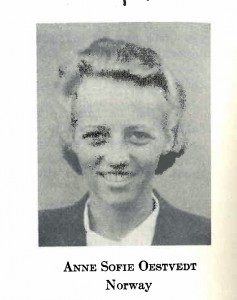In today’s excerpt from our new book Basics of Resistance, we look into Chapter 3: On the Shoulders of Giants, a brief glimpse at some of the others who have taken on the mantle of resisting. Some did it correctly, some didn’t. The woman in today’s story, however–Anne Sofie Østvedt–did it amazingly well, making herself perhaps the ultimate invisible “gray woman.”

Image from the AAUW Image Archives.
Anne Sofie Østvedt was a 20-year-old chemistry student when German forces invaded Norway in 1940. Unhesitatingly, she plunged into resistance work. First, she wrote, edited, and distributed an illegal anti-Nazi newspaper, then later joined more hardcore resisters. All the while she tried to continue her education—and managed to do so for two more years.
While it was common in resistance movements for a woman to be a writer, courier, spy, supporter, or even an armed fighter, Østvedt rose through the ranks of the resistance group XU to become its second-in-command. That meant that she served as the representative of XU’s leader in contacts with other underground organizations. At times when the leader was away, she served as commander over 3,000 men.
This was an era when not many men would have been willing to be led by a woman. But few of them knew they were being led by a woman—because XU practiced great secrecy and used the type of highly compartmentalized organizational structure we’ll describe later in this book.
In 1942, when the Gestapo arrested one of her collaborators, the Germans launched a manhunt for Østvedt. They sent 45 officers to block all routes and entrances to her apartment. When they couldn’t find her, the Gestapo took her sister as a hostage.
Despite the heightened danger, Østvedt stayed in Norway and continued her resistance work. But it was now imperative to assume a new identity, adopting a new name and new documents. To do this successfully, she had to change her appearance and break all ties with friends, family, and fellow students. For 2-½ years she had to do without a private life, family life, or friendships. Most of us will never have any idea how hard that is.
But Østvedt was so dedicated to resistance and to protecting her fellow fighters that she never slipped up. Not even once. She never reached out to an old friend. Never confided in anybody. Never so much as sent a note to her family to let them know she was okay. One time, she stood next to her father on a bus. He didn’t recognize her, and she didn’t identify herself to him.
After the Nazis fell, Anne Sofie Østved came to America where she completed a masters degree, then returned home to a quiet life with her husband—a man who had also been the chief commander of XU.
Lessons:
- One lesson we’ve seen before and will see again: discretion. When you are doing dangerous work—underground and illegal—you must observe the utmost standards of security. You don’t confide in friends. You don’t make unnecessary contacts with outsiders, not even the closest and most-loved. You tell only what people need to know.
- If you must become another person, you also never let your guard slip. You don’t frequent old haunts. You don’t wear the same type of clothes your former self did. You don’t enjoy the same habits or pursue the same pleasures. You become somebody else.
- Another lesson (not that we should need it in these days of greater equality) is that the right person can fulfill any role in resistance, regardless of who or what they are—as long as their skills, capabilities, and personality are a match for the job.
- And finally, when you care about something passionately enough, you will be prepared to make any personal sacrifice, endure any amount of loneliness, and put up with the harshest privation to fulfill your commitments.
Basics of Resistance is available for pre-order as of April 1st! You can get your copy here.

but what do you do when you have a visible tattoo so avoid that at all costs
There are many kinds of resistance, which we talk about in the book. In this case, a visible tattoo would have ruined her–and would ruin anyone involved in certain pursuits. Having a visible tattoo, however, doesn’t bar you from any and all resistance. As the saying goes, only put tattoos where they can be covered up in front of a judge, and you’re probably okay for most things (unless, of course, you are wearing long sleeves on a 95-degree day because you’re trying to cover up the tattoos, etc. Use your head, obviously).
Haha i like you guys- you’re deliciously paranoid! When i was little my hillbilly grandfather instructed me that tattoos were foolish. That how the government tracks you! Took it to heart, despite being tempted,i never got one. No distinctive birthmarks either.
A great thumb-nail sketch!
“We shall learn the landscape from the paintings of the Masters…”
All resistance is victory.Not all balls are on men.
Tatoos can be changed or modified.
Good story of a very courageous woman.
Is it really available or is it an April fools joke?
It’s really available for pre-order on Kindle. No joke. Official release date is April 19.